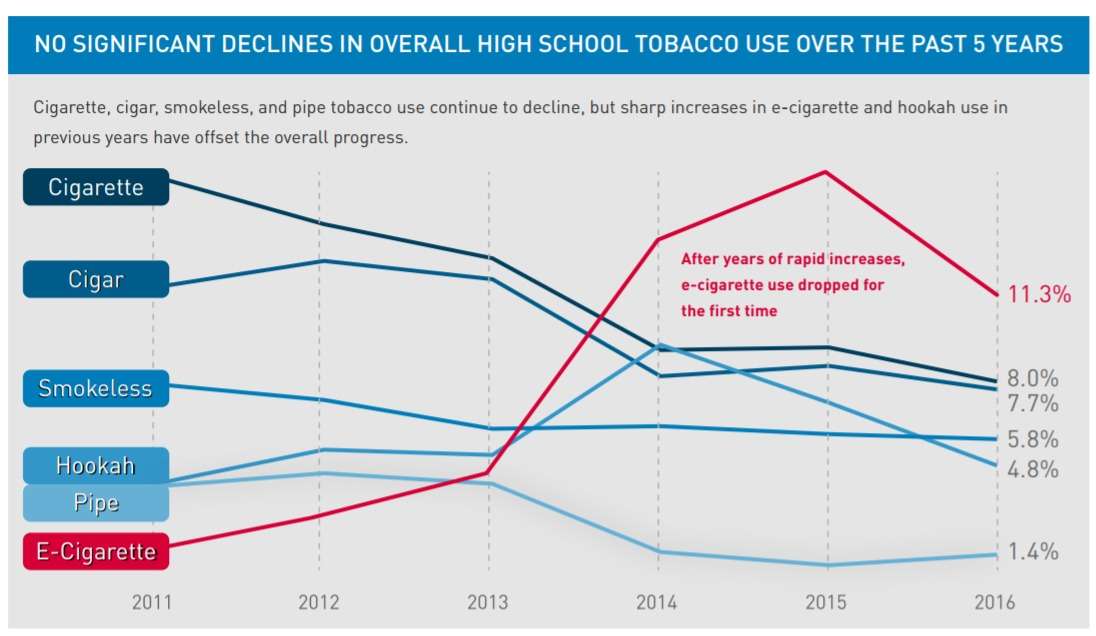FDA Lies About Vaping While the CDC Inches Toward the Truth
Federal officials deny big reductions in adolescent tobacco use and obscure the harm-reducing potential of e-cigarettes.

Between 2011 and 2016, according to survey data from the U.S. Centers for Disease Control and Prevention, cigarette smoking by teenagers fell by half, cigar smoking fell by a third, pipe smoking fell by two-thirds, and smokeless tobacco use fell by a quarter. Yet according to the Food and Drug Administration, there were "no significant declines in overall high school tobacco use" during that period. How is that possible?
Let me answer that riddle by posing another one. If you call an e-cigarette a tobacco product, and the incidence of past-month vaping among high school students more than sextupled from 2011 to 2016, how does that affect the trend in overall tobacco use? The answer is that it does not affect the trend in overall tobacco use at all, because calling an e-cigarette a tobacco product does not make it a tobacco product.
Yet that is what FDA does, partly for regulatory reasons. E-cigarette fluid often contains nicotine derived from tobacco, which supposedly transforms a tobacco-free product into a tobacco product, giving the FDA authority to regulate it. The FDA maintains that pretense even when reporting what is happening in the real world. The result, as Boston University public health professor Michael Siegel notes on his tobacco policy blog, is an alternative reality where dramatic declines in adolescent tobacco consumption never happened. The CDC plays the same game, falsely claiming "current use of any tobacco product did not change significantly" among high school students from 2011 to 2016.
This blatant misrepresentation magnifies a problem (underage tobacco use) that the FDA and the CDC are charged with addressing, making their work seem more urgent and more worthy of funding. It also conflates e-cigarettes, a noncombustible, tobacco-free alternative to conventional cigarettes, with products that are far more dangerous, obscuring the enormous harm-reducing potential of this innovation. By lumping e-cigarettes in with tobacco products, the FDA and CDC may hope to scare kids away from them. But the message to current smokers—that they might as well keep puffing away, since all these nicotine sources are essentially the same—is potentially deadly.
A new CDC webpage about e-cigarettes gives some ground on that score, conceding that "e-cigarettes have the potential to benefit adult smokers who are not pregnant if used as a complete substitute for regular cigarettes and other smoked tobacco products." But by insisting that e-cigarettes be a "complete substitute," the CDC dismisses the health benefits of smoking less, even if the number of cigarettes per day does not fall to zero.
"Dual use is not an effective way to safeguard your health," the CDC says. "Because smoking even a few cigarettes a day can be dangerous, quitting smoking completely is very important to protect your health." This slippery formulation deliberately obscures the fact that smoking a few cigarettes a day is less dangerous than smoking a pack or two a day. If e-cigarettes help smokers make that change, they are reducing tobacco-related harm.
The CDC's discussion of how the health hazards of vaping compare to those of smoking is similarly misleading. "Are e-cigarettes less harmful than regular cigarettes?" it asks. "Yes—but that doesn't mean e-cigarettes are safe. E-cigarette aerosol generally contains fewer toxic chemicals than the deadly mix of 7,000 chemicals in smoke from regular cigarettes. However, e-cigarette aerosol is not harmless. It can contain harmful and potentially harmful substances, including nicotine, heavy metals like lead, volatile organic compounds, and cancer-causing agents."
Sadly, it counts as an improvement that the CDC is willing to explicitly say e-cigarettes are less harmful than regular cigarettes instead of dodging the question entirely. But you would not guess from its gloss that vaping is something like 95 percent safer than smoking, that potentially harmful substances in e-cigarette aerosol are typically present only in trace amounts, or that smokers who switch to vaping see big reductions in blood levels of toxins and carcinogens—at least as big as the reductions seen in smokers who switch to FDA-approved "nicotice replacement therapy" such as gum and patches.
The CDC now grudgingly accepts that smokers who switch to vaping are better off, but it still worries that nonsmokers will take up vaping. To deter them, the CDC inflates the risk posed by e-cigarettes, which also deters smokers from switching, even though that decision could save their lives. The only way out of this conundrum is one the CDC never seems to consider: Instead of slanting information in the hope of manipulating people's behavior, why not tell them the truth and let them make their own decisions?




Show Comments (31)